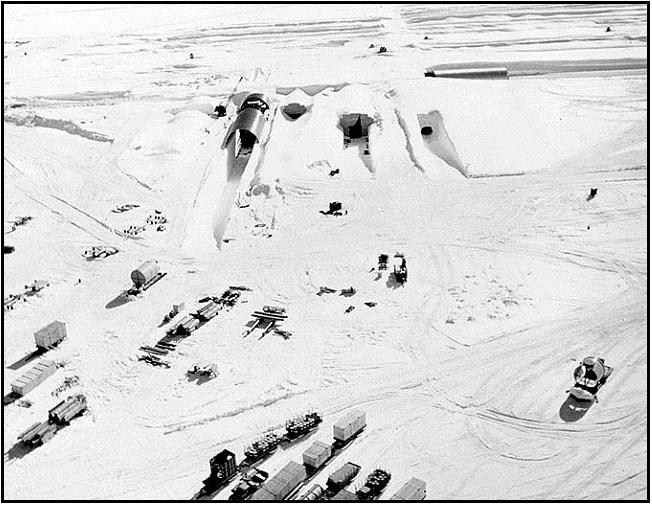Melting ice sheet could release frozen Cold War-era waste

The northeast portal to Camp Century during construction in 1959. Image: US Army
The U.S. military base “Camp Century,” built in the Greenland Ice Sheet in 1959, served as a top-secret site for testing the feasibility of nuclear missile launch sites in the Arctic during the Cold War. When the camp was decommissioned in 1967, its infrastructure and waste were abandoned under the assumption they would be entombed forever by perpetual snow.
But climate change has warmed the Arctic more than any other region on Earth. Recent findings from a new study at York University in Canada, conducted in collaboration with the University of Zurich, indicate that the portion of the ice sheet covering “Camp Century” could start to melt by the end of the century. If the ice melts, the camp’s infrastructure, including any remaining biological, chemical, and radioactive wastes, could re-enter the environment and potentially disrupt nearby ecosystems.
Waste beneath the ice
In the study, the researchers took an inventory of the wastes at “Camp Century” and ran climate model simulations to determine whether the waste would remain intact in a warming Arctic. The team analyzed historical U.S. army engineering documents to determine where and how deep the material was buried and to what extent the ice cap has moved since the 1950s.
“Camp Century” – today some 35 meters beneath the ice – covers 55 hectares. The researchers estimate the site contains 200,000 liters of diesel fuel. Based on building materials used in the Arctic at the time, the authors speculate the site contains polychlorinated biphenyls (PCBs), pollutants toxic to human health. They also estimate the site has 240,000 liters of waste water, including sewage, along with an unknown volume of low-level radioactive coolant from the nuclear generator used to produce power.
Environmental and political implications
Looking at existing business-as-usual climate projections, the team determined the wastes would not remain encased in ice forever. “The climate simulations indicate that perpetual slow won’t last forever; indeed, it seems likely that the site could transition to net melt as early as 2090,” according to co-author Horst Machguth, Department of Geography at the University of Zurich. Once the site transitions from net snowfall to net melt, it’s only a matter of time before the wastes melt out and are transported to the marine ecosystems.
Nevertheless, the study does not advocate immediate remediation activities at Camp Century. The waste is buried tens of meters below the ice and any cleanup activities would be costly and technically challenging. The authors say it is therefore advisable to wait until the ice sheet has melted down to almost expose the wastes before beginning site remediation.
“Two generations ago, people were interring waste in different areas of the world, and now climate change is altering those sites,” said lead author William Colgan, a climate and glacier scientist at York University in Toronto, Canada. “It’s a new breed of political challenge we have to think about.”
((Box))
A “city under the ice”
In April 1951, the U.S. and Denmark agreed to defend Greenland, a Danish territory, from potential Soviet attacks. In 1959, the U.S. Army Corps of Engineers built Camp Century 200 kilometers inland from the Greenland coast. The camp’s official purpose was to test construction techniques in the Arctic and conduct research.
The camp’s other aim was to provide proof of concept for a top secret program to test the feasibility of building nuclear missile launch sites. Scientists took ice core samples to chart climate data. When the camp, which housed 85 to 200 soldiers and was powered by a nuclear reactor, was decommissioned, the army removed the nuclear reaction chamber but left the camp’s infrastructure and all other waste behind.
Literature:
Colgan, W., H. Machguth, M. MacFerrin, J. D. Colgan, D. van As and J. A. MacGregor (2016): The abandoned ice-sheet base at Camp Century, Greenland, in a warming climate, Geophysical Research Letters, doi: 10.1002/2016GL069688.
http://www.media.uzh.ch/en/Press-Releases/2016/Camp-Century.html
Media Contact
All latest news from the category: Earth Sciences
Earth Sciences (also referred to as Geosciences), which deals with basic issues surrounding our planet, plays a vital role in the area of energy and raw materials supply.
Earth Sciences comprises subjects such as geology, geography, geological informatics, paleontology, mineralogy, petrography, crystallography, geophysics, geodesy, glaciology, cartography, photogrammetry, meteorology and seismology, early-warning systems, earthquake research and polar research.
Newest articles

Can lab-grown neurons exhibit plasticity?
“Neurons that fire together, wire together” describes the neural plasticity seen in human brains, but neurons grown in a dish don’t seem to follow these rules. Neurons that are cultured…

Unlocking the journey of gold through magmatic fluids
By studying sulphur in magmatic fluids at extreme pressures and temperatures, a UNIGE team is revolutionising our understanding of gold transport and ore deposit formation. When one tectonic plate sinks…

3D concrete printing method that captures carbon dioxide
Scientists at Nanyang Technological University, Singapore (NTU Singapore) have developed a 3D concrete printing method that captures carbon, demonstrating a new pathway to reduce the environmental impact of the construction…



